The Saskatchewan Railway Museum is a railway museum located west of Saskatoon, Saskatchewan at the intersection of the Pike Lake Highway and the Canadian National Railway tracks. It is operated by the Saskatchewan Railroad Historical Association (SRHA) and was opened 1990.
Innovation Place is the registered business name of the Saskatchewan Opportunities Corporation (SOCO), a crown corporation in Saskatchewan. SOCO operates two research parks: one located near the University of Saskatchewan in Saskatoon, Saskatchewan, and the second near the University of Regina in Regina, Saskatchewan. In 2018, approximately 140 companies were based at Innovation Place. Research parks such as Innovation Place are sometimes referred to as science parks or technology parks.
Floral, Saskatchewan is an unincorporated community in the province of Saskatchewan, Canada.

Eastview is a mostly residential neighbourhood located in south-central Saskatoon, Saskatchewan, Canada. It is a suburban subdivision, consisting of low-density, single detached dwellings, low-rise apartment buildings and semi-detached houses. As of 2007, the area is home to 3,566 residents. The neighbourhood is considered a middle-income area, with an average family income of $58,703, an average dwelling value of $260,050 and a home ownership rate of 51.6%. According to MLS data, the average sale price of a home as of 2013 was $318,449.

The Exhibition subdivision of Saskatoon, Saskatchewan, Canada, is located on the banks of the South Saskatchewan River and was developed between the two major World Wars. To the west is the Diefenbaker Management Area which boasts the Diefenbaker park and Pioneer Cemetery. The park includes a medium-sized hill which is used for tobogganing and snowboarding, and the park itself is a frequently-used venue for picnics and public events and performances. The Exhibition community is also known as Thornton, after a (now-demolished) public elementary school that formerly served the area and early in its history also went by the name Bellevue.

Rugby Chapel is a municipal historic site which is part of the University of Saskatchewan. The U of S is the largest education institution in the Canadian province of Saskatchewan. The University of Saskatchewan location next to the South Saskatchewan River was across from the city centre of Saskatoon. In 1879, the Rt. Rev. John McLean started a schooling system in Prince Albert which was renamed the University of Saskatchewan in 1883. In 1909, when the University of Saskatchewan was established in Saskatoon, Emmanuel College moved its college buildings to Saskatoon. The Institute for stained glass in Canada has documented the stained glass at Rugby Chapel.

CJMK-FM is a radio station serving Saskatoon, Saskatchewan. Owned by Saskatoon Media Group and broadcasting on 98.3 FM, the station broadcasts a classic hits format branded as "98 Cool FM".

The Forestry Farm Park and Zoo is a forested park and zoo located in Saskatoon, Saskatchewan, Canada. The park was originally established as the Dominion Forest Nursery Station and later Sutherland Forest Nursery Station. Between 1913-1966 was responsible for growing and shipping 147 million trees shipped across the northern prairie provinces. The first shipment of trees were sent to farmers in 1916. The park is designated a National Historic Site of Canada. The nursery grew caragana, ash, maple, elm, and willow. After the nursery closed in 1966 a portion was re-opened as a city park.

Osler is a town in the Canadian province of Saskatchewan, founded in the 1890s. The community was named after Sir Edmund Boyd Osler (1845–1924), who was an Ontario-based explorer, railroad financier, and Member of Parliament.
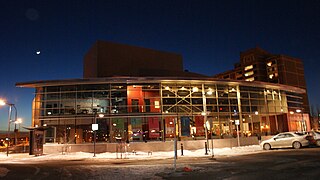
Frank & Ellen Remai Arts Centre is a performing arts centre in the River Landing area of Saskatoon, Saskatchewan, Canada. The centre is owned by and the main venue for the Persephone Theatre. Constructed in 2007 at a cost of $11 Million Canadian, the main theatre seats 450, with a second smaller 100 seat theatre and other supporting facilities and workshops that make up the centre.
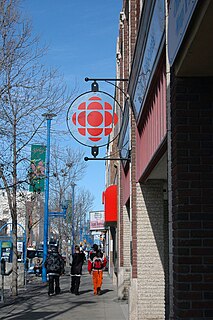
The Hutchinson Building is a landmark building located in downtown Saskatoon, Saskatchewan, Canada. The building was designed by architect Frank P. Martin built to house the Saskatoon Hardware Store Ltd until 1970 then the building was taken over by Saskatoon Handicraft Supplies until 1995. The building was designated a heritage property on August 9, 1999.

The Arrand Block is a historic building located in the Nutana neighborhood of Saskatoon, Saskatchewan, Canada. The building was built by James and Walter T. Arrand, owners of the James and Walter T. Arrand Contractors' Company; Arrand Construction Company intended to use two of the apartments as their homes. Original features of the building include two story apartments, with sky lights on the top floor. The building was designated a heritage property on April 10, 1989.
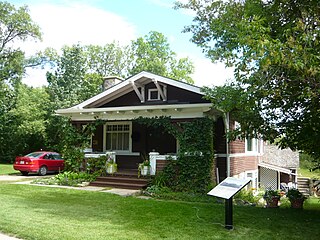
The Bowerman House is a designated Municipal Heritage Property located in the Holiday Park, neighborhood of Saskatoon, Saskatchewan, Canada. The home is of a crafts-man "Western Stick" style. The house was built as a hunting lodge by Allan Bowerman, graduate from Kingston Military College, first postmaster in Saskatoon on the west side of the river, and member of Saskatoon's first town council. Bowerman was also responsible for the development of the Canada Building. The home was designed by Walter William LaChance. Bowerman sold the home in 1917 after the end of a construction boom in the city.

The Canada Building is a historic eight-story office block in the Central Business District of Saskatoon, Saskatchewan, Canada. The building is 35.05 m (115.0 ft) in height featuring red granite facing on the base, with terra cotta details on the lower two floors and cornice near the roof. The office building features large bison heads flanking the main doorway.
The 2nd Avenue Lofts is a historic building located in the Central Business District of Saskatoon, Saskatchewan, Canada.
The Landa Residence is a designated Municipal Heritage Property located in the Riversdale, neighborhood of Saskatoon, Saskatchewan, Canada. Thomas E. Heath, Saskatoon's Early Fire Chief lived in the home from 1913–1915. In 1921, the house became the family residence of William and Fanny Landa, the first Jewish family to settle in Saskatoon. William Landa was a carriage maker who immigrated from Russia established the Landa Carriage Works that eventually become the Landa Auto Body Works. The building is of a Pre-World War I Prairie Vernacular architectural style.

The Albert Community Centre is a designated Municipal Heritage Property located in the Varsity View, neighborhood of Saskatoon, Saskatchewan, Canada. Originally built as the Albert School, the two-and-a-half storey brick building served as a public school until 1978 when the building was sold to the city and became the Albert Community Centre. The school was originally named for Prince Albert, Queen Victoria's Consort. The most noticeable feature of the building include limestone trim, crenellated tower, crossed mullioned windows, dormers and curved parapet gables.
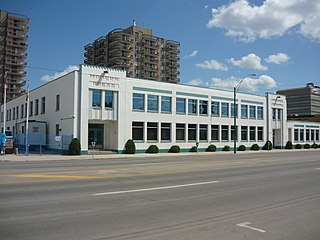
The Modern Press Building is a historic building in the City Park District, of Saskatoon, Saskatchewan, Canada. The original building was designed by David Webster.

The Adilman Building is a historic building in the Riversdale district of Saskatoon, Saskatchewan, Canada. It is one of Saskatoon's remaining examples of Streamline Moderne architecture.
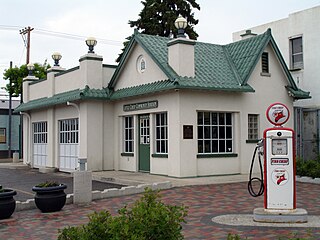
The Little Chief Service Station is a designated Municipal Heritage Property located in the Riversdale, neighborhood of Saskatoon, Saskatchewan, Canada. It was originally built as a gas service station for Texaco Oil Company of Canada. Cars and farm vehicles were often serviced at the station while owners shopped in the Riversdale area. The restored building design makes use of white stucco walls, rounded roof tiles, decorative brick, heavy tiled cornices, roof parapets, iron windows and copper gutters.


















